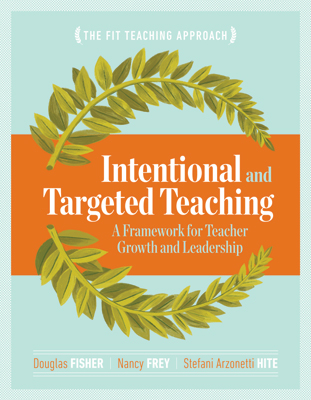“Academic press is absolutely necessary, but not sufficient to operationalize the mission of the school. . . . No school improvement effort will be effective, maintained, or enhanced unless school culture and academic press are both addressed and aligned” (Fisher, Frey, & Pumpian 2012, p. 5). Within the FIT Teaching™ model, school and classroom culture is a critical prerequisite to implementing effective instruction.
THE 5 PILLARS
In their book How to Create a Culture of Achievement, Fisher, Frey, and Pumpian. identify five pillars that are critical to student achievement. These pillars are useful when working to implement a strong school and classroom culture. They are also invaluable when examining the current state of affairs in your learning environment.
Pillar 1: Welcome
Imagine checking into a hotel and waiting a long, long time to be helped, only to then be treated brusquely at the front desk and shuffled off, unceremoniously, to your room. You would probably choose never to patronize that hotel again.
Similarly, many visitors to schools and classrooms often feel as though they are an unwelcome disruption rather than an honored guest. The same goes for students as well. This pillar suggests that educators need to make a conscious effort to establish a welcoming environment for all learners and visitors.
How do we know our school and classrooms are welcoming?
- Try the secret shopper method and invite a stranger to visit and have them report back.
- Send out a student and/or parent survey asking for anonymous feedback.
- Hold student focus groups to allow free discussion about the nature of your welcoming environment.
Pillar 2: Do No Harm
Behavior issues—often referred to as disciplinary issues—are a sticky subject for many schools and classrooms. Discussions around behavior issues and how to respond to misbehavior monopolize time and can often be emotionally charged.
This pillar describes the importance of all adults agreeing to be the models of correct behavior. This begins with the adults discussing behavioral goals and expectations and making a concerted effort to work together to hold everyone (not just students) to the agreed upon standards. In such an environment, one teacher doesn’t permit gum chewing in class while another ignores it. With this approach, school rules have a purpose and are consistently monitored. Ultimately, however, the goal is for students to self-regulate so that “enforcement” becomes a moot point.
How do we know our school and classrooms subscribe to a policy of “do no harm”?
- Survey the students about school rules. Don’t just ask if they know the rules, but ask if they know why the rules are important.
- Audit your discipline referrals. What are the trends, patterns, and commonalities? Do certain issues warrant further action—perhaps a more concerted effort on the part of all staff?
- Survey the teachers. What do they believe are the major behavioral issues? Do their answers match what your audit results suggest?
Pillar 3: Choice Words
In his book Choice Words, Peter Johnston writes, “Language . . . is not merely representational (though it is that); it is also constitutive” (2004, p. 9). He shares an example of a teacher asking students questions for which she already knows the answers. This reinforces the teacher’s role as the font of all knowledge and students as recipients. In another example, a teacher announces that the class will have free choice time, but only after finishing the reading task first. This subtly indicates that the reading is a necessary work chore to be completed before having “fun.”
According to this pillar, the language teachers choose to use has a great effect on how students come to view their lives at school, the tasks they are to complete, and their roles as learners. Consider the nuanced difference between these exchanges:
Student: I’m having trouble correcting the grammar in this sentence.
Teacher: What have I taught you about subject-verb agreement?
Or …
Student: I’m having trouble correcting the grammar in this sentence.
Teacher: As a writer, what have you learned about subject-verb agreement?
In the first example, the teacher is firmly in control of the knowledge and expects the student to recall what has been taught. In the second example, the teacher reinforces that the student is a writer who is learning the critical aspects of a writer’s craft.
How do we know our school’s educators choose words carefully?
- Teachers can self-assess the language they use in the classroom. Are they phrasing things in a way that creates a sense of agency for their students?
- Administrators can support teachers’ self-assessment by collecting observation data and sharing it with teachers so they can reflect on their language choices.
Pillar 4: It’s Never Too Late to Learn
The best time to plant a tree was 20 years ago. The second best time is now.
This Chinese proverb suggests that there is value in working toward achieving goals no matter how late we are in getting started or how daunting the task may seem. This idea is particularly relevant for our students, who arrive at school with test scores labeling them a certain number of years “below grade level.”
This pillar suggests that all educators must believe that students can be successful and competent learners—not merely compliant students. In her book Mindset (2006), Carol Dweck describes the power of people’s beliefs. In the first mind-set she depicts, one believes abilities are etched in stone, permanent and immutable. Our intelligence is fixed and thus we hold a fixed mind-set. In the other mind-set, one believes that learning and achievement can be cultivated through hard work and perseverance. In this example, we hold a growth mind-set.
Imagine the difference for students when administrators and teachers in their school regard them with growth mind-sets, not fixed ones! Combine this with the notion of choice words and compare these statements made by a teacher:
Wow, great work on this project. You are so smart.
Or …
Wow, great work on this project. You put a lot of thought and effort into it.
In the first example, the student is reminded that her inherent intelligence was responsible for her success. This creates a lot of pressure for a student—what happens if that intelligence isn’t enough? In the second example, the student’s work and effort is acknowledged. Hard work is not a finite resource. When a student struggles, perseverance will see them through.
How do we know our school and classrooms are places where it’s never too late to learn?
- Review the content and level of cognitive tasks given to students. Do they represent high expectations for all?
- Analyze formative and summative assessments for the depth of knowledge required. Are the questions asking students to recall and reproduce or to analyze information and extend their thinking?
- Discuss academic recovery efforts in your classrooms and your school. What happens when students don’t achieve as expected? What supports are in place?
Pillar 5: Best School in the Universe
Although this statement might invoke images of bragging educators—We work at the best school!—it is actually about members of a school holding themselves accountable for creating the best possible environment for students. This pillar suggests a continuous improvement effort in order to make a school great. Teaching is a complex and demanding job that requires constant attention from motivated individuals in order to be effective.
In his book Drive: The Surprising Truth about What Motivates Us (2009), Daniel Pink identifies three critical aspects of motivation: autonomy, mastery, and purpose. Autonomy speaks to our ability to be self-directed in our work and learning. Mastery describes our desire to get good at something. Purpose reflects our wish to pursue meaningful tasks—not busy work or artificial assignments.
These principles can be applied to the work of educators and the work of students within a school. After all, the best school in the universe is one that’s a great place to work as well as a great place to learn.
How do we know our school and classrooms are the best in the universe?
- Are students’ tasks challenging, authentic, and relevant?
- Do tasks offer students choices and collaborative opportunities?
- Are supports designed so that students can master important learning?
- Are educators given opportunities to be self-directed?
- Are educators given opportunities and supports to continuously improve their craft?
- Are educators engaged in meaningful pursuits that have a direct effect on student learning?
Don’t get too caught up in your curriculum without considering the environment. FIT Teaching™ begins with a culture of achievement.
REFERENCES:
Dweck, C. S. (2006). Mindset: The new psychology of success. New York, NY: Ballantine.
Fisher, D., Frey, N., Pumpian, I. (2012). How to create a culture of achievement in your school and classroom. Alexandria, VA: ASCD.
Johnston, P. H. (2004). Choice words: How our language affects children’s learning. Portland, ME: Stenhouse.
Pink, D. H. (2009). Drive: The surprising truth about what motivates us. New York, NY: Riverhead Books.
 (Warning: shameless self-promotion ahead )
(Warning: shameless self-promotion ahead )

